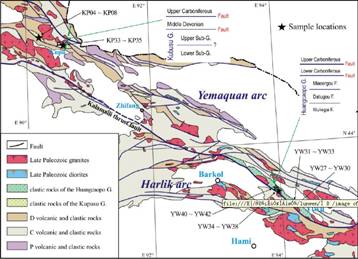Geochemistry and U–Pb Detrital Zircon Dating of Paleozoic Graywackes in East Junggar
2012-05-29
The Central Asian Orogenic Belt (CAOB), also termed the Altaids, is a large accretionary orogenic belt bounded by the Siberian Craton to the north and the Tarim–North China Craton to the south. This orogenic belt was formed by Early Neoproterozoic to Late Paleozoic subduction–accretion processes, which resulted in accretion of island arcs, ophiolites, other suprasubduction units, and terranes with Precambrian crystalline basement to the southern margin of the Siberian Craton. A complex history of subduction–accretion processes makes it difficult to distinguish the origin of these various terranes and reconstruct the tectonic evolution of the southern CAOB.
The Junggar Block is one of the largest terranes in the southern CAOB and is located between the Chinese Altai and Tianshan orogenic belts. It is traditionally divided into three parts: Junggar Basin, East Junggar and West Junggar. The Junggar Basin is mainly filled with pre-Carboniferous marine and post-Carboniferous continental sediments, whereas the East and West Junggar are dominated by igneous rocks, which form the basin ranges. Based on the geochemical and Nd juvenile isotopic features of igneous rocks surrounding the Junggar Basin, previous studies have interpreted Junggar block as a fragment of accreted oceanic crust and/or a volcanic arc of Early Paleozoic age. The suture zone that stitches the Siberian plate to the Tarim plate, and to which plate the Junggar Block belongs has been a subject of debate for the past several years.
In order to provide constraints on the accretionary history, researchers analyzed major and trace element compositions of Paleozoic graywackes from the Huangcaopo Group (HG) and Kubusu Group (KG) in East Junggar. The HG graywackes have relatively low Chemical Index of Alteration (CIA) values (50 to 66), suggesting a source that underwent relatively weak chemical weathering. The identical average Index of Compositional Variability (ICV) values (~1.1) for both the KG and HG samples point to animmature source for the Paleozoic graywackes in East Junggar, which is consistent with an andesitic–felsic igneous source characterized by low La/Th ratios and relatively high Hf contents. These graywackes are geochemically similar to continental island arc sediments and therefore probably deposited at an active continental margin. U–Pb dating of detrital zircons fromthe lower subgroup of the HG yielded a young age peak at ~440 Ma, indicating a post-Early Silurian depositional age. However, the youngest populations of detrital zircons from the KG graywackes and the upper subgroup of the HG yielded 206Pb/238U ages of ~346 Ma and ~355 Ma, respectively, which suggest a post-Early Carboniferous depositional age. Because of similarities of rock assemblages, these two units should be incorporated into the Early Carboniferous Nanmingshui Formation. The detrital zircon age spectrum of the Early Paleozoic HG graywackes resembles that of the Habahe sediments in the Chinese Altay, which suggests that the ocean between East Junggar and the Chinese Altai was closed before the deposition of the sediments and that the Armantai ophiolite was emplaced prior to the Early Devonian. The differences in age spectra for detrital zircons from the post-Early Carboniferous graywackes in East Junggar and the Harlik arc indicate that the emplacement of the Kalamaili ophiolite postdates the Early Carboniferous. Therefore, a long-lasting northward subduction–accretion process is suggested for the formation of East Junggar and the reconstruction of the Early Paleozoic evolution of the southern CAOB.
Main findings of this study have been published on Gondwana Research, 2012, 21: 637-653. The paper is also archived at http://www.sciencedirect.com/science/article/pii/S1342937X11001663.

Geological map of East Junggar with sample locations



